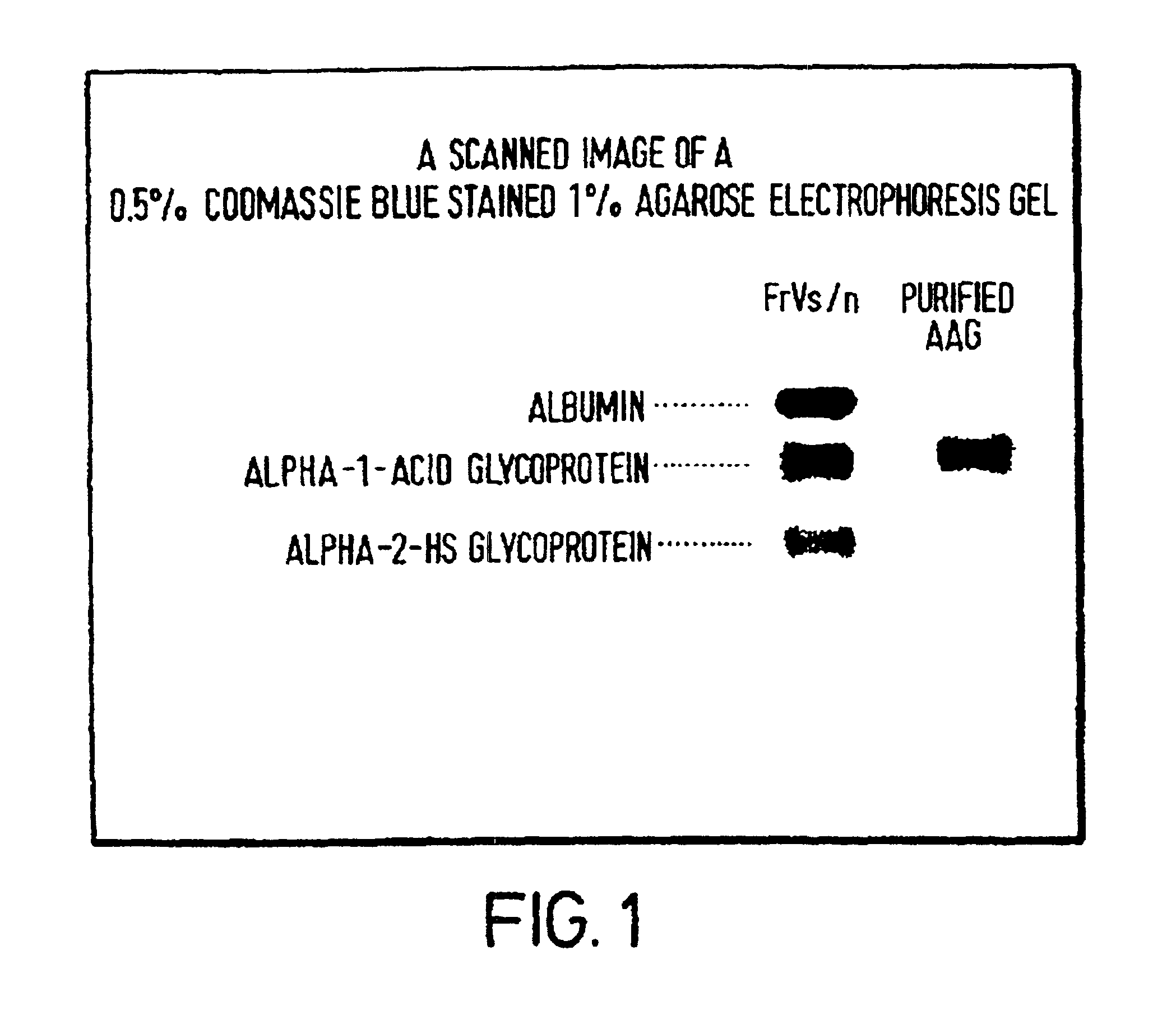Purification method
a technology of alpha1acid glycoprotein and purification method, which is applied in the field of improved methods for purifying alpha1acid glycoprotein, can solve the problems of unsuitable human therapy, laborious and time-consuming purification methods, and unsuitable for large-scale preparative processes, and achieves a slight stabilising effect and prolong heating
- Summary
- Abstract
- Description
- Claims
- Application Information
AI Technical Summary
Benefits of technology
Problems solved by technology
Method used
Image
Examples
example 1a
Purification of Technical Grade Alpha-1-Acid Glycogrotein (AAG) Form Fraction V Supernatant
[0060]DEAE Sephadex A-50 gel, (Pharmacia), is supplied as a dry powder. 675 g of dry gel was swollen overnight in 100 liters of 0.25M sodium acetate (NaAc), pH unadjusted. After swelling the gel was batch equilibrated with 4 aliquots of 0.13M NaAc, pH 4.1, conductivity=1.85 mS / cm. The gel was drained after each aliquot. A total of 250 liters of equilibration buffer was used. Approximately 450 liters of Fraction V Supernatant, produced by the method of Kistler and Nitschmann plasma fractionation (Vox Sang, 7, 414-424, 1962), was added to the equilibrated gel and mixed for 90 minutes. The unbound protein solution was drained from the gel. The gel was washed with 4 aliquots of 0.13M NaAc, pH 4.1, conductivity=1.85 mS / cm. The resultant washed gel cake was batch eluted with 35 liters of 0.13M NaAc, 1M sodium chloride (NaCl), pH 4.1. This produced 41.8 kg of eluate solution. 3 liters of 1M Sodium Hy...
example 1b
Purification of Clinical Grade α1 Acid Glycoprotein (AAG) from Fraction V Supernatant
Column Preparation
[0061]Q Sepharose Big Bead (25.2 cm×19 cm−9.5 liters) was depyrogenated with 30 liters of 0.5M Sodium Hydroxide (NaOH) for 1 hour. The gel was equilibrated with So liters of 0.13 M Sodium Acetate (NaAc) pH 4.1.
Fraction V Supernatant Preparation
[0062]This was prepared according to the method of Kistler and Nitschmann, Vox Sang. 7, 414-424 (1962).
AAG Preparation
[0063]1.1 750 liters of Fraction V Supernatant was depth filtered at <0° C., warmed to 10° C., then loaded onto the gel at 2 liters per minute. After loading, the column was washed with 50 liters of 0.13M NaAc pH 4.1, to wash off the unbound protein.
[0064]1.2 AAG was eluted with 50 liters of 0.13M NaAc, 0.2M Sodium Chloride (NaCl) pH 4.1 at 2 liters per minute. The gel was cleaned with 50 liters of 0.13M NaAc, 1M NaCl pH 4.1 then 20 liters of 0.5M NaOH and stored in 10 mM NaOH.
[0065]1.3 The eluted AAG was neutralised with NaOH...
example 2
Selection of Suitable Anion Exchange Resins for Use in Preparing AAG from Fraction V Supernatant for Subsequent Depyrogenation
[0073]The high ethanol content (40%) makes Fraction V supernatant very difficult to process. This may be due to its high relative viscosity (2.8 at 20° C.).
[0074]The initial approach was to remove ethanol and concentrate by ultra filtration but the large volumes and low flux rates (due to ethanol) were found to make processing times extremely long. Instead chromatographic capture directly from Fraction V supernatant was chosen, ideally without modifying pH, or ethanol concentration. Most anion exchangers have very low capacity under these conditions and high back pressures allowing only low throughput and requiring large volumes of anion exchanger. Hence to improve process feasability an anion exchanger with good capacity (>10 g AAG / L gel) at high flow rates was sought.
Method
[0075]A wide range of anion exchange resins were selected, both Q and DEAE derivative...
PUM
| Property | Measurement | Unit |
|---|---|---|
| concentration | aaaaa | aaaaa |
| concentration | aaaaa | aaaaa |
| molecular weight | aaaaa | aaaaa |
Abstract
Description
Claims
Application Information
 Login to View More
Login to View More - R&D
- Intellectual Property
- Life Sciences
- Materials
- Tech Scout
- Unparalleled Data Quality
- Higher Quality Content
- 60% Fewer Hallucinations
Browse by: Latest US Patents, China's latest patents, Technical Efficacy Thesaurus, Application Domain, Technology Topic, Popular Technical Reports.
© 2025 PatSnap. All rights reserved.Legal|Privacy policy|Modern Slavery Act Transparency Statement|Sitemap|About US| Contact US: help@patsnap.com


